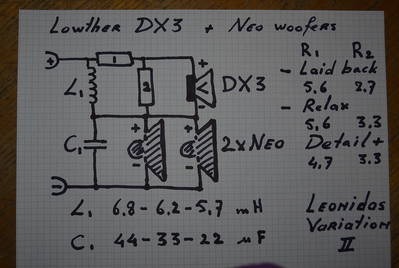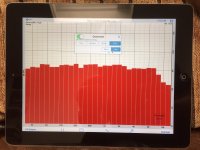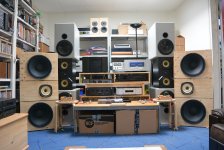My listening room is approximately 15X30 and the ceilings are vaulted. I hear it is difficult to get open baffle bass below 30hz which is about what I think I am getting with my Kazba with 10" drivers. The sound is great though so I am exploring the option of trying to build something open baffle instead of employing a sealed sub for those last few hz. So can something "reasonable" be built open baffle that has great 20-200 bass or am I looking at building something comparable to a Visaton Grande Orgue. And is it worth it; I've also heard that in small rooms a sealed sub won't excite room modes much from 20-50. Let the fighting, ehr, I mean constructive comments begin. (This wouldn't be half the fun if we all agreed on everything though would it? )
It's a noble and worthy endeavor to seek dipole bass as low as possible. But without a sealed back it may be very hard to generate rumble that deep. How far away is your listening position from the sub?
To get 20Hz with a larger Kazba it may be possible. CLS's Kazba used dual 18's but he had rather low Qts pro audio woofers. A pair of Eminence Alpha 15's in a Kazba may have a better shot at 20Hz, say 5 ft away.
Maybe CLS can chime in what his low extension was. IMO, if you are hitting 30Hz you are doing very well.
Note that bandpass injection into a short horn with an open back can achieve 30Hz. With some wings on the back perhaps 20Hz can be had? Bushmeister was able to get 30H easily with very low HD. I would imagine some EQ would allow 20Hz with a little more distortion.
To get 20Hz with a larger Kazba it may be possible. CLS's Kazba used dual 18's but he had rather low Qts pro audio woofers. A pair of Eminence Alpha 15's in a Kazba may have a better shot at 20Hz, say 5 ft away.
Maybe CLS can chime in what his low extension was. IMO, if you are hitting 30Hz you are doing very well.
Note that bandpass injection into a short horn with an open back can achieve 30Hz. With some wings on the back perhaps 20Hz can be had? Bushmeister was able to get 30H easily with very low HD. I would imagine some EQ would allow 20Hz with a little more distortion.
Carver's dipole 'sub' alignment gives a good account of the basics to low dipole bass design and the 'wall of science' you're going to be 'beating your head' against doing it in a relatively large acoustic space with readily available 'sub' drivers; not impossible, just about as practical to do as its corollary, a same gain BW reactance annulled BLH: Carver Amazing Loudspeaker (Platinum Edition) | Stereophile.com
GM
GM
5' to listening position is doable.
Good to hear Kazba might work for this. I like the look too.
And I've had my eye on this PRV 15" Resonant frequency of 31, .62qts and 5.5 xmax $68.00!
PRV Audio 15W700 15" High Power PA Woofer 8 Ohm
Do you think it would better the Alpha in a Kazba? Alpha's at 41hz, 1.26qts and 3.8xmax
Good to hear Kazba might work for this. I like the look too.
And I've had my eye on this PRV 15" Resonant frequency of 31, .62qts and 5.5 xmax $68.00!
PRV Audio 15W700 15" High Power PA Woofer 8 Ohm
Do you think it would better the Alpha in a Kazba? Alpha's at 41hz, 1.26qts and 3.8xmax
I am using the MCM 21" woofer in a U-frame stuffed with denim insulation. 6 db boost at about 30 hz, and a high pass filter set for 20 hz. No 20 hz response, but I get very good bass down to 30 hz. Best bass I have ever had in my room. Before this I was using a pretty good subwoofer, but took it out because I was getting plenty of good bass from the OB woofers.
The GR Research servo OB 12" drivers and matching plate amps are the best thing I've heard, and are what I've been using at home for a few years now. The plate amps can drive either two or three of the drivers each. I use two drivers a side in a smaller room than yours- but they will go far louder than I can stand.
Just to maybe add a bit of common sense into the thread. The reason why dipoles are effective at improving the bass response within a room is due to the way they energise the rooms modal region. In small acoustic spaces the modal region has a defined end point. In my room this is 40Hz. In smaller rooms this would be higher in frequency and larger ones lower.
The point here is that once the rooms modal region has ended there is absolutely no point in bothering with a dipole. There are no room modes or issues for the dipole to try and fix.
Dipoles are an often acceptable answer to improving bass reproduction in small acoustic spaces but they come with the huge penalty of terrible efficiency. Going lower only makes this worse. Put simply there is no point in going dipole below the rooms modal region. You should go sealed or better yet with a well designed ported box.
The point here is that once the rooms modal region has ended there is absolutely no point in bothering with a dipole. There are no room modes or issues for the dipole to try and fix.
Dipoles are an often acceptable answer to improving bass reproduction in small acoustic spaces but they come with the huge penalty of terrible efficiency. Going lower only makes this worse. Put simply there is no point in going dipole below the rooms modal region. You should go sealed or better yet with a well designed ported box.
Those are under my trigger too; when I'll happen to have 500$ disposable or 1000$ ( I like dual channel, dunno...! ) probably yes ( probably not  )
)
The GR Research servo OB 12" drivers and matching plate amps
Just to maybe add a bit of common sense into the thread. The reason why dipoles are effective at improving the bass response within a room is due to the way they energise the rooms modal region. In small acoustic spaces the modal region has a defined end point. In my room this is 40Hz. In smaller rooms this would be higher in frequency and larger ones lower.
The point here is that once the rooms modal region has ended there is absolutely no point in bothering with a dipole. There are no room modes or issues for the dipole to try and fix.
Dipoles are an often acceptable answer to improving bass reproduction in small acoustic spaces but they come with the huge penalty of terrible efficiency. Going lower only makes this worse. Put simply there is no point in going dipole below the rooms modal region. You should go sealed or better yet with a well designed ported box.
Are you suggesting that, below the modal region of the room, a single monopole source will produce a flat response at all listening positions?
FWIW, I managed 20Hz on OB. Just. It was a Beyma 15P1200Nd a side, with around 30dB boost at the bottom end, after my DEQ2496 had finished with it.
Sitting around 3m away, cone excursion was quite visible on the low notes. No nasty noises, but they are very good drivers that can handle being put in silly situations like that one. Peak power delivery was hundreds of watts, but listening levels were, at best, moderate.
Chris
As reported by others it is difficult to get to 20 Hz with a dipolar reproduction system because of the room modal region. Linkwitz and others suggest a monopole subwoofer to augment the lowest frequencies if you need to cover those sounds.
Perhaps the question to ask yourself is what kind of low frequency sound do you hear from from acoustic instruments? If your goal is to reproduce stand-up bass, drums, or similar low frequency sounds then that kind of bass is not the chest thumping sound pressure levels heard from overly amplified instruments. If you listen to such acoustic instruments, then you will realize that dipolar sound reproduction is more natural.
Perhaps the question to ask yourself is what kind of low frequency sound do you hear from from acoustic instruments? If your goal is to reproduce stand-up bass, drums, or similar low frequency sounds then that kind of bass is not the chest thumping sound pressure levels heard from overly amplified instruments. If you listen to such acoustic instruments, then you will realize that dipolar sound reproduction is more natural.
Last edited:
"So you're telling me there's a chance!" Seriously though, I like the idea of trying a larger Kazba with the PRV's. It's a reasonably priced driver, good specs and great reviews and if I don't like it as well as my smaller Kazba I can employ it as an effective, albeit large, sealed subwoofer. I must admit I am tempted to go your route Decker with the big unit to see what it sounds like.
Natural is the word I use to describe my open baffle bass and that is what I like about it. 5th Element out of curiosity, how does one implement a good ported sub. They seem to get a lot of bad press for things like transient response, one note bass and then of course there are the box problems that people seem to dislike.
Had them free standing in other room ; not much difference so. Measures about the same. Took this photo just to prove (to some guy) that I was able to A-B two large systems. The other system is with 2x 11 inch Eton bass down to 25 Hz (these are with dbx driverack PA & 6x 250 watts).
Feeling silly after doing OB setup ; there is NO way back to conventional system !!
It's just more musical and audiophile.
I did an XO for PureAudioProject ; they use it for Voxativ , Lowther e.o.
Just look at their page ; Leonidas XO.
And , yes , I do use room gain optimal !!
Feeling silly after doing OB setup ; there is NO way back to conventional system !!
It's just more musical and audiophile.
I did an XO for PureAudioProject ; they use it for Voxativ , Lowther e.o.
Just look at their page ; Leonidas XO.
And , yes , I do use room gain optimal !!
There is one guy one this sute who is waaaaaay more experienced than anyone else on DIY open baffle bass down to very low Fs at very high SPL's
....http://www.diyaudio.com/forums/multi-way/142015-my-open-baffle-dipole-beyma-tpl-150-a-119.html
Stig Erik is the man! He is a dedicated high end hard core DIY builder who really knows his stuff and has all the energy and resources it takes to design and build killer systems.
Every question you have will be answered
"I have very low THD up to about 100 dB @ 20 Hz, but that is simply not enough SPL for home cinema."
all the best
Derek.
....http://www.diyaudio.com/forums/multi-way/142015-my-open-baffle-dipole-beyma-tpl-150-a-119.html
Stig Erik is the man! He is a dedicated high end hard core DIY builder who really knows his stuff and has all the energy and resources it takes to design and build killer systems.
Every question you have will be answered
"I have very low THD up to about 100 dB @ 20 Hz, but that is simply not enough SPL for home cinema."
all the best
Derek.
IIRC (?) Carver's woofer had qts of ~"3" - a GW1858 will play to fs (30) on a fairly small baffle. I did not like the 21" Madison woofer - could have been the light baffle vs high moving mass or cranked too hard but sounded lousy on cello. Maybe Pooh has a suggestion.
hi Leon - what woofer did you use for the following crossover? - trying to see if similar could be hodge-podged with
a Fostex FE206EN

hi Leon - what woofer did you use for the following crossover? - trying to see if similar could be hodge-podged with
a Fostex FE206EN
Last edited:
- Status
- This old topic is closed. If you want to reopen this topic, contact a moderator using the "Report Post" button.
- Home
- Loudspeakers
- Full Range
- The quest for 20hz open baffle bass

